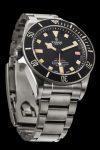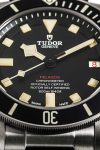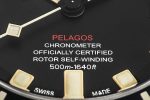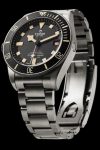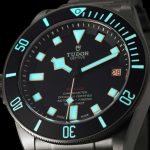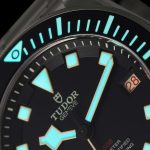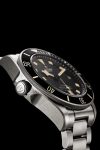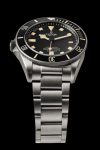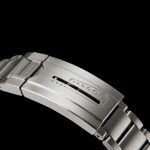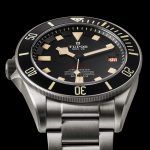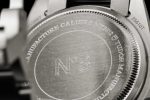Reviews
Tudor Pelagos LHD: God Is In The Details
And in modern watchmaking, there is no single timepiece that more perfectly represents the symbiosis between unlimited performance and thoroughly seductive design than the extraordinary Tudor Pelagos.
With its name derived from the Greek word referring to the deep sea, the Tudor Pelagos represents the single greatest value in the dive watch sector; it is an example of supreme ethical pricing, as well as an amazing technical innovation, in an era lacking in true creativity and where watch prices have veered out of control.
It is, in essence, everything that is good about modern watchmaking.
The latest edition of the Pelagos is a unique left-handed or “destro” watch with roots that hark back to the military heritage of Tudor. This watch also introduces a new vintage-themed update to the Pelagos that, combined with its amazing technical innovation, creates a delicious union between the past and the present.
But before delving into all the glorious details of the new Pelagos LHD (or “Left Hand Drive”), let’s remind ourselves that almost every detail of the Pelagos is in some ways born out of Tudor’s legendary collaboration with military divers, in particular those of France’s Marine Nationale.
To read Ross Povey’s two-part epic on Tudor’s history with the Marine Nationale and other Navies please click here and here.
The most famous of Tudor’s military dive watches were the so-called “snowflake” Submariners, refs. 9401 and 9411, adopted for use by the French Marine Nationale. You could even say that the unique dial configuration, characterized by a graphic language never before seen in watchmaking, was the direct result of this partnership and is a union that is still perfectly expressed by the modern-day Pelagos LHD dive watch.
In what ways were the dial and hands of the Pelagos — in particular, the watches commissioned as active-service timepieces worn by military divers — born out of the historic relationship between Tudor and the French Navy?
The dial of the modern Pelagos takes its design lineage from the legendary “snowflake” Tudor watch that emerged in 1969 and that was widely adopted by navies and military units around the world, in part for its unique visual qualities.
Look at this dial and you’ll see that its markers are characterized in a very specific design language driven by Tudor’s relentless desire to provide the ultimate in dive watch visibility. The 12 o’clock marker is an inverted luminous triangle while the 3, 6 and 9 markers are luminous rectangles.
While the aforementioned features are fairly common in professional dive watches, the remaining indices are thick square blocks — this unique geometric arrangement allows for the maximum amount of immediate and totally intuitive identification of the time in the dark.
To add to this, the modern Pelagos also features the legendary “snowflake” shaped hour hand and baton-shaped minute hand from the Submariner refs. 9401 and 9411— and both features were a result of Tudor’s close relationship with the Marine Nationale.
The feedback from the military divers was that at depth with limited clarity and no light, it was at times challenging to distinguish the “Mercedes” shaped hour hand from the longer baton-shaped minute hand, in particular when the former overlapped the latter. While the name of the individual who designed the now-legendary “snowflake” hand is unknown, this unique element may well be one of the most visually arresting and legendary time-telling elements in the history of modern horology.
The totally unique nine-sided hand had never before appeared in watchmaking, yet show any watch lover an image of it and he will immediately break into a grin and say, “Tudor”, such is its immediate recognizability.
When painted with luminous material, the special “snowflake” shape enables it to be instantly distinguished from the minute hand no matter the conditions, and we see a wonderful example of function defining design in Tudor history.
Take a close look at the Pelagos’ dial and you’ll see a masterwork of dizzying three-dimensional details to optimize time-telling visibility in all conditions. While the original markers were simply printed onto the dials, here, all of the 12 markers are applied, to help distinguish them from the matte dial and allow for a much thicker application of luminous material.
Then, there is the material itself known as Chromalight, an in-house version of the ubiquitously used Super-LumiNova. Chromalight was perfected at Rolex’s internal research and development facility to optimize brightness and retention of luminosity — it glows a unique shade of blue, which aids in visibility when the watch is submerged.
Why the choice of blue luminescent material in this watch? It’s because Tudor took into account that when a watch is submerged, different colors are absorbed at different depths.
Water absorbs red light and, to an extent, yellow, green and violet light. The color least absorbed by water is blue light. Blue has an approximate depth of total absorption of 275m while red has an approximate absorption depth of just five meters.
As such, the ice-blue glow of the Pelagos yet again evinces Tudor’s total dedication in creating the most functional watch conceivable.
Furthermore, the masterful execution of the dial flange which bears the minute markers sees it elevated on a canted track to aid in readability, while the flange itself follows a geometric pattern to surround each of the hour markers.
Indeed, the Pelagos LHD combines vintage and contemporary details like no other Pelagos model before. The dial harks back to the matte dial found on the vintage Tudor Submariner ref. 9401 of the late 1960s and 1970s but feature gilt-style gold writing and minute makers that are inspired by the earliest Tudor Submariner ref. 7922 with no crown guards, as well as the iconic 7928 model, the first Submariner to feature crown guards.
And yet there is the remarkable addition of the word “Pelagos” in red writing, something that comes not from Tudor’s heritage but that of its sibling brand Rolex — in particular, the red printed line is found in the legendary “red” Submariners and “single” and “double red” Sea-Dwellers.
In addition, the white date wheel with alternating red and black numerals is most associated with the “roulette wheel” date indicator found in the Tudor Prince Oysterdate Submariner ref. 7021 (this was the first Submariner with a date). On the roulette wheel, odd-numbered dates are printed in black while even number dates are printed in red.
Finally, adding to the plethora of vintage elements in the Pelagos LHD are the cream-colored Chromalight indices, which evoke the wonderful color of aged radium or tritium found on vintage Tudor dive watches. Of course, the use of this color treatment in the Chromalight does nothing to affect the high-visibility signature blue color it emits in darkness.
This incredible cream-colored Chromalight is also featured in the Pelagos bezel. And at this juncture, we need to pause to take a look at one of the most brilliant and technically innovative advances in watchmaking: the ceramic bezel featuring luminous minute markers that is unique to the Tudor Pelagos.
When launched in 2012, the Tudor Pelagos was a revelation. First, with its breathtaking combination of retro details like a “snowflake” hour hand and pointed crown guards contrasted by its modern titanium case, it rapidly became recognized as one of the most uniquely designed and highly appealing dive watches on the market.
Secondly, it completely redefined value in the dive watch category by packaging a watch with a host of technical innovations — titanium case, a ceramic bezel, a helium-release valve, 500 meters of water-resistance, and an expanding and contracting deployant clasp — at an accessible price point.
Thirdly, it demonstrated Tudor’s relentless pursuit of functional innovation, which is perfectly characterized by its ceramic luminous bezel.
OK, so by now, you probably understand that a dive bezel is meant to show elapsed dive time by reading the minute hand of the watch relative to the minute hash markers printed on the bezel. But ask yourself this: How many dive watches have luminous minute hands?
The answer is, all of them. Now ask yourself this: How many modern dive watches with traditional rotating bezels have luminous hash marks so that elapsed dive time can be accurately read underwater or in darkness?
First, it capitalizes on its sibling company Rolex’s mastery of ceramic bezel inserts. But recognizing the functional aspects of the dive bezel, it became the first brand to integrate luminous hash marks into the bezel using Chromalight.
In addition to this, the Pelagos does away with the traditional but fragile luminous “pearl” found at the 12 o’clock marker. Because the watch uses luminous Chromalight for all its bezel markers, Tudor simply created an inverted triangle with an outline of a circle integrated into it as a clever clin d’œil or wink to its past even while innovating for its future.
The advantage of the ceramic bezel is that it is almost totally scratchproof, with a Vickers hardness second only to diamond.
Read the words printed on the dial under the heroic red “Pelagos” sobriquet regarding the watch’s depth rating and you’ll realize that at 500m water-resistance, the Pelagos boasts more than double the average water-resistance of a traditional dive watch.
This is achieved with two innovations that reach back to the very roots of Tudor’s sibling company Rolex’s history. The first is the screw-down back — once the movement is fitted into the back of the case, the caseback is fitted using threaded grooves milled into the case, which provides much higher water-tightness than the ubiquitous snap-on or press-fitted backs used by other brands at the time.
The second signature innovation relates to the screw-down crown, which was patented by Rolex founder Hands Wilsdorf and used for both his brands. As such, the very first Tudor Submariner ref. 7922 already featured this highly effective method of protecting the crown from water intrusion.
To read more about the famous “Big Crown” Tudor Submariners and why Tudor decided to add crown guards to its dive watches click here.
Found on either side of the Pelagos LHD’s crown are Tudor’s iconic “pointed crown guards”, which are metal shoulders that protect the crown against accidental knocks — this was again a featured that was added based on feedback from divers, such as those in France’s Marine Nationale.
The very first Tudor Submariner to feature crown guards was the ref. 7298. The original crown guards were square-shaped, but the feedback was that they made the crown challenging to manipulate, so Tudor changed their configuration to the now-famous pointed crown guards, a favorite amongst vintage collectors that is used on the Pelagos as a brilliant nod to Tudor’s own heritage.
Look at the case of the Pelagos and you will be immediately seduced by its thrilling dark case color and strikingly appealing brushed “tool watch” surface finish. While the watch at 42mm in diameter makes a bold presence on the wrist, you’ll be surprised at how light it is.
That’s because the case, crown, bezel and bracelet assembly of the Pelagos is crafted from one of the most groundbreaking metals in the aerospace industry — titanium. Titanium is stronger than steel but only half its weight, and it is a totally non-corrosive used for medical implants.
It has also been used with great effect in aviation and aerospace, and has revolutionized performance sports from golf to cycling to auto-racing. As such, the idea of a titanium watch became a significant goal for the Swiss watch industry in the 1980s.
But one issue related to titanium is that it can ignite during the milling and polishing operations, so special technologies had to be developed to enable safe construction of titanium watches. The Pelagos and the Pelagos LHD gain historic significance as the first titanium watches ever created by either Tudor or its sibling company Rolex (the Rolex DeepSea with a depth rating of 3,900m features a titanium caseback but a steel case).
Therefore, that the case of the Tudor Pelagos and its LHD version is constructed in titanium is a true testament to the high-performance intentions of this model.
Simply put, the experience of putting a Pelagos on your wrist, then living with it on a daily basis, is incredibly rewarding because of how every aspect of the watch from its dial and hand configuration to its luminous bezel to its self-adjusting deployant clasp is optimized to make it perform better than any other watch in its category.
Add the watch’s lightweight, thanks to its titanium case, and you don’t just have a great choice for a dive watch, but also an overwhelming winner in its field.
Born out of the collaboration with deep-sea saturation divers in the field of oil exploration, the feature came about because in order to combat decompression sickness on a mission, industrial deep-sea divers would not resurface after each dive but would instead spend time in specially pressurized chambers underwater and breathe in a synthetic mixture of gas that includes helium.
During this time, helium molecules, which are far smaller than oxygen molecules, could get trapped inside the watch. After a week, or when the divers finally resurfaced, the helium molecules inside the watch could expand as they approached the surface, causing calamities such as the crystals exploding off the watches.
In 1967, Tudor’s sibling company Rolex created dive watches for the industrial divers of COMEX (Compagnie Maritime d’Expertises), a company which pioneered deep-sea diving for oil exploration.
The watches were Sea-Dwellers with cases retrofitted with helium-release valves, which allowed the helium trapped inside the watches to be safely discharged during resurfacing. In 1988, COMEX divers during a pipe-connection exercise set a world open-sea diving record by achieving a depth of 534m, and this was accomplished with the Rolex Sea-Dweller featuring the helium-release valve strapped to their wrists.
What is remarkable is that in the history of both Rolex and Tudor, only three watches have ever been given the honor of having the helium-release valve integrated into their cases — the original Sea-Dweller, the ultra-deep-saturation Sea-Dweller Deepsea and the Tudor Pelagos.
Considering the presence of this valve, and the existence of both the screw-down crown and caseback, one is inclined to believe that the true water-resistance of a Pelagos far exceeds the 500m depth rating printed on its dial.
Considering it’s just a tick above CHF4,000, the value of the Pelagos and Pelagos LHD is remarkable.
Here you have a watch with a titanium case, a unique bezel with a ceramic luminous insert, a masterful union of vintage and modern design codes, a helium-release valve, and a COSC certified in-house movement with a silicon hairspring — all for the price of what its competitors would charge for a basic steel dive watch with an outsourced non-chronometer-certified movement. What more could Tudor possibly provide with the Pelagos?
Well, a lot more as it happens. Because when you open the box of your Tudor Pelagos, deposited inside it is a rubber strap, and a second rubber strap with a dive extension for wearing over a wetsuit, as well as a titanium bracelet.
When you attach the titanium bracelet and put it on your wrist, you will marvel at yet another one of Tudor’s brilliantly pragmatic innovations.
The deployant clasp of the Pelagos bracelet has a spring-loaded function that allows its circumference to expand and contract with your wrist. This was initially designed because when you put a waist on your wrist with a wetsuit and you go diving, your wetsuit will expand and contract depending on what depth you are at.
The amazing deployant clasp allows for a corresponding expansion and contraction. And while this feature was created for diving, it is also highly functional in everyday use. Take, for example, an average workday in a tropical climate such as Singapore.
When you step out into the heat and humidity, your wrist expands considerably and when you go back indoors, the highly air-conditioned low-humidity environment causes your wrist to contract. While other brands offer what is known as a “tropical link”, or a fine adjustment option, with the Pelagos, this change is self-regulating. Finally, it is an appealing nod to the vintage Rolex 6636 stretchable bracelets found on certain models.
Look at the three lines of print on the dial under the word “Pelagos” in red, just beneath the cannon pinion. They read, “Chronometer / Officially Certified / Rotor Self-Winding” — each of these printed lines is incredibly significant.
The first two lines reveal that the movement within the watch, Tudor’s in-house manufacture cal. MT5612, is independently certified as a chronometer by the Contrôle Officiel Suisse des Chronomètres (COSC), which was founded in its current form in 1973 to test watches to ensure that they ascribe to chronometric levels of accuracy, i.e. up to -4 /+6 seconds a day in five different positions.
Only three percent of all watches manufactured in Switzerland are awarded this certificate. The movement of the Pelagos is also “automatic”, which is expressed by the charmingly retro verbage “rotor self-winding” used in vintage Tudor watches.
But don’t be mistaken — the in-house MT5612 is a thoroughly modern high-performance motor featuring a 4Hz (28,800vph) and variable-inertia balance wheel and a silicon hairspring. A variable-inertia balance wheel means that the heartbeat of the balance wheel is controlled using weights that are integrated into the rim of the balance, which offers the most resilient type of fine adjustment.
The silicon hairspring is unaffected by magnetism. These two features are incredibly important because loss of accuracy in timing is among the top reasons for watches needing to be serviced.
And the two greatest culprits are watches that need a small beat or rate adjustment or watches that have become magnetized, where the coils in their hairspring have become magnetically attracted to one another. By virtually eliminating these two factors, Tudor has created a watch with a supreme level of reliability.
So, why a left-handed version of the Tudor Pelagos? While the inspiration for the watch was several special Tudor Submariners created specifically for left-handed Marine Nationale divers, there is another reason that the right-handed watch lover can benefit tremendously from the Pelagos LHD.
That’s because by relocating the crown to the left-hand side, and wearing the watch on your left wrist as most of us do, you eliminate any contact between your wrist and the crown and crown guards, creating the ultimate in comfort.
To read about athletes, such as Serena Williams, who have specially made left-handed watches even though they are right-handed for this very reason, click here.
And finally, why is the Pelagos LHD a numbered edition even though it is not a limited series? This is a thrilling homage to the fact that all Marine Nationale “snowflake” Submariners were engraved with a military reference code on their casebacks.
In summary, every detail of the Pelagos and the new Pelagos LHD has been born out of a desire to create unrivaled performance while simultaneously paying respect to Tudor’s extraordinary history in military dive watches.
The Pelagos is more than a timepiece; it is a statement of heroism for the wrist, and an invitation to the adventure your life should be. That, and all of the advantages it offers, makes the Pelagos the very best value in dive watches today, so that buying one is not a decision but a moral imperative.
Photography & Art Direction: Sidney Teo
Fashion Styling: Marie Lee
Post-Production Artist: Ciwie Goh
Hair and Makeup Artist: Rina Sim using Dior and Living Proof
Models: Ingrid F / Upfront




